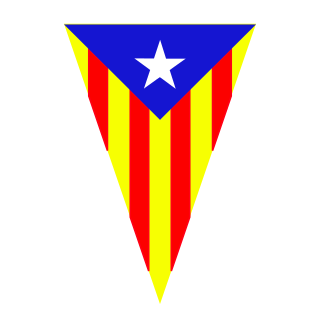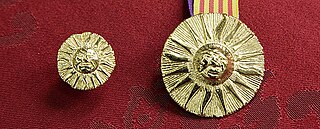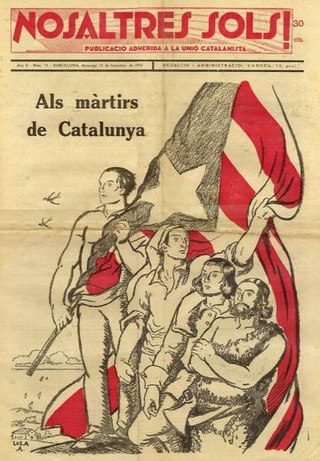
Francesc Macià i Llussà was a Catalan politician who served as the 122nd president of the Generalitat of Catalonia, and formerly an officer in the Spanish Army.

Lluís Companys i Jover was a Catalan politician who served as president of Catalonia from 1934 and during the Spanish Civil War.

Estat Català is a pro-independence nationalist historical political party of Catalonia (Spain).

Marcel·lí Perelló i Domingo born in was a Catalan guerrilla politician and newspaper writer. He was the first Secretary of Estat Català. He was part of a plot against the Spanish Throne, was imprisoned and exiled to Mexico.
The Free Catalan Territory are those declared municipalities or regions of Catalonia that had approved a motion in a plenary session by the councillors of the town or the region council, as they represent the municipality's local authority. Such motions declare that Spanish laws and regulations are considered provisional, waiting for the Government and Parliament of Catalonia to enact new Catalan laws after having assumed national sovereignty, and therefore turning Catalonia into an independent state.
The Sis Hores de Cançó in Canet de Mar was a mass festival of Catalan singing in a time when Catalan, as a language and as a culture, was somehow persecuted by the Spanish Francoist dictatorship. The embryo of this festival can be found in an event that Agrupament Escolta dels Pioners from Canet de Mar organized in the local tennis club court in August 1969. Their leader was Joan Ramon Mainat, brother of Josep Maria Mainat, one of the three members of a hugely popular Catalan band called La Trinca. Most of the greatest Catalan singers involved in the struggle to gain acknowledgment of Catalan as an official language performed there: Lluís Llach, Ovidi Montllor i Francesc Pi de la Serra. Attendance was about 500 people. In April 1970 they organized another concert, which gathered more people.

The National Front of Catalonia was a Catalan nationalist party which was active between 1940 and 1990. The FNC was created in 1940 by former members of the Estat Català and the Catalan Nationalist Party, with the latter dissolving and splitting its membership between the Estat Català and the FNC. The main goals of the FNC were to present an opposing front to the Spanish State of caudillo Franco and to advocate for Catalan independence. In 1946, the FNC became an officially independent party by breaking its relationship with the Estat Català.

Jaume Aiguader i Miró was a Spanish medical doctor, writer, social activist, politician and Catalan nationalist. He was one of the founders of the Republican Left of Catalonia political party. He became Mayor of Barcelona, and was a national deputy during the Second Spanish Republic. He was Minister of Labor and Social Assistance in the government of Juan Negrín during the Spanish Civil War (1936–1939). After the fall of the Republic, he died in exile in Mexico.

Josep Tomàs i Piera was a Spanish lawyer and politician. He became active in politics, and was elected to the Spanish legislature in 1933 on the platform of the Republican Left of Catalonia. During the Spanish Civil War (1936–1939) he was briefly Minister of Labor, Health and Social Welfare in the first government of Francisco Largo Caballero, before being made Spanish consul in Montreal, Canada. After the war he lived in exile in Mexico, where he was a leader of the Catalan community.

Bonaventura Gassol i Rovira, known as Ventura Gassol, was a Catalan poet, playwright and politician. A nationalist, he was prominent member of the Esquerra Republicana de Catalunya.
The Diario de Barcelona was a newspaper founded in 1792 in Barcelona, Catalonia, Spain. With a few interruptions it was published in paper form until 1994, and in digital form until 2009, making it one of the oldest newspapers in Europe. It has been called the most important newspaper in Barcelona's history, or the first real chronicle of Barcelona.

The 1934 Barcelona City Council election was held on Sunday, 14 January 1934, to elect the Barcelona City Council, the unicameral local legislature of the municipality of Barcelona, together with the other 1,029 Catalan municipalities. At stake were all 40 seats in the City Council, determining the Mayor of Barcelona. These were the first local elections where women were able to vote.

Miquel Badia i Capell (1906–1936) was a prominent figure of radical Catalan separatism during the days of the Second Spanish Republic, member of Estat Català and the JEREC, Chief of Public Order of the Generalitat of Catalonia. He became known among his followers as Capità Collons.
Daniel Cardona i Civit, also known with the pen name of Vibrant or the nickname of l'Irlandès, was a Catalan politician, a prominent figure of 20th-century radical Catalan separatism.

The Ramon Llull Award is an honor awarded annually by the Government of the Balearic Islands to persons or entities of the Balearic Islands that have excelled in any field. It was established in 1997 by Decree 3/2014.

Nosaltres Sols! was a Catalan nationalist paramilitary political movement from the 20th century. It was born in 1931, in a rented space property of the political party Unió Catalanistaand created a weekly journal with the exact same name as well. The purpose of the organization was to confront those who were considered enemies of Catalonia, mainly Spanish unionists, but also anarchists, communists and fascists.

The Catalan coup d'etat was an unsuccessful takeover of power in autonomous Catalonia, planned by the independentist party Estat Català. The conspirators intended to declare the total independence of Catalonia as a state neutral in the Spanish Civil War, and to marginalize all non-aligned political groupings, especially the Anarchists. They counted on party militias and Catalan army and security units, infiltrated by the Estat Català militants. The coup was planned in November, as the plotters assumed that the central Republican government, absorbed by the battle of Madrid, would not be able to take action. The plot failed because of the Anarchist counter-action, which exposed the scheme and some of its leaders. In pre-emptive strike Generalitat services detained a few of the conspirators; the others fled to France. Estat Català was sidelined, while CNT-FAI ensured its dominant position in Catalonia. The attempted coup remains a poorly researched and rather unknown episode; in historiography it is discussed against the background of Catalan fascism.

Bandera Negra or Santa Germandat Catalana was the secret, armed sub-organization of the Estat Català political party, founded on May 3, 1925.

The plot of Prats de Molló, better known in Catalan historiography as the events of Prats de Molló,, was an attempted military invasion of Catalonia carried out from France to achieve its independence planned by Francesc Macià and the leadership of the Estat Català party, discovered and aborted in 1926. The plan consisted of the penetration of two columns, which were to occupy Olot and proclaim the Catalan Republic.















